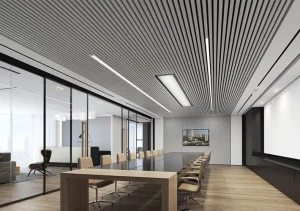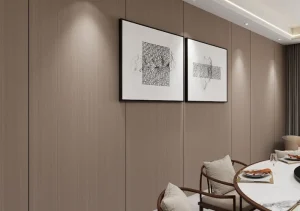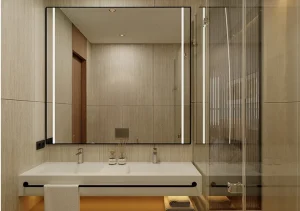Table of Contents
ToggleIntroduction
In modern architecture, acoustic performance has become just as important as aesthetics and functionality. Whether in office buildings, schools, hotels, theaters, or residential projects, the demand for quiet, comfortable, and acoustically balanced environments is growing rapidly. Ceiling acoustic panels, as one of the most effective and versatile sound absorption solutions, have been widely adopted in global architectural design. They not only improve sound quality and reduce noise but also enhance the overall appearance of interiors, aligning perfectly with the pursuit of modern spaces that combine performance and beauty.
This article will provide a comprehensive overview of the applications of acoustic panels for ceilings in modern architecture. We will explore their working principles, product types, installation methods, benefits, and their use across multiple fields. Furthermore, we will analyze current market trends and future development prospects, with a focus on how acoustic ceiling panels are shaping the architectural industry.
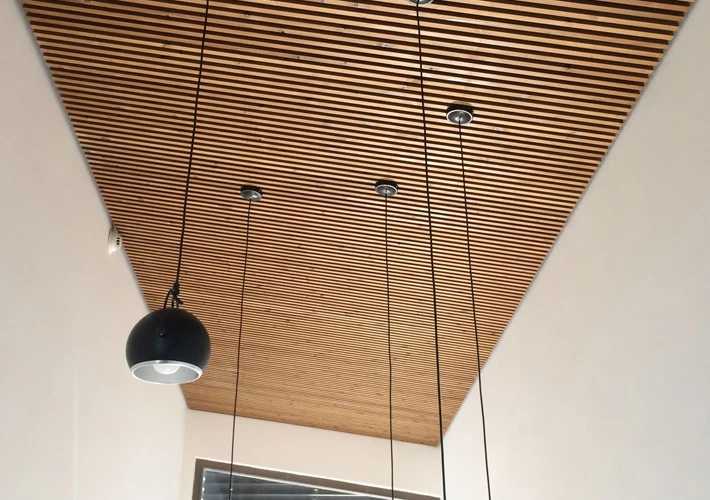
The Role of Acoustic Panels in Modern Architecture
1.1 Balancing Aesthetics and Acoustics
Modern architectural projects require spaces that are visually appealing and acoustically comfortable. Ceiling acoustic panels solve this challenge by combining sound absorption properties with decorative design flexibility, ensuring that interior spaces look sophisticated while meeting noise reduction requirements.
1.2 Enhancing Acoustic Comfort
By reducing reverberation and echo, acoustic ceiling panels create environments where speech intelligibility is improved. This is particularly crucial in classrooms, conference halls, or open-plan offices where communication clarity impacts efficiency and productivity.
1.3 Supporting Sustainable Development
Many ceiling acoustic panels are made from eco-friendly materials such as recycled PET, wood wool, or bamboo-based composites. These sustainable choices not only comply with green building standards (such as LEED or BREEAM) but also resonate with the global push toward low-carbon architecture.
How Acoustic Ceiling Panels Work
Acoustic ceiling panels operate on the principle of sound absorption. When sound waves hit the panel surface, a portion of the energy penetrates the porous material inside, where friction and air resistance transform sound energy into heat, reducing reflections within the room.
Key technical factors include:
- NRC (Noise Reduction Coefficient): Measures the effectiveness of sound absorption (ranges from 0 to 1). Ceiling panels often achieve NRC ratings between 0.70 and 0.95.
- Density and Thickness: Higher density and thicker panels generally offer stronger absorption across low and mid frequencies.
- Surface Texture: Perforated, slatted, or fabric-covered designs can optimize absorption at different frequencies while enhancing aesthetics.
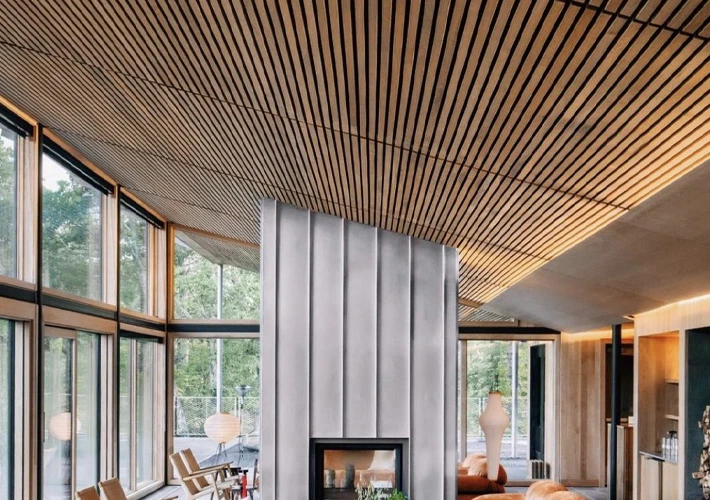
Types of Acoustic Ceiling Panels in Modern Architecture
3.1 Mineral Fiber Acoustic Panels
- Made from mineral wool or fiberglass.
- Lightweight, cost-effective, and widely used in offices and schools.
- Offer fire resistance and high NRC values.
3.2 Wooden Acoustic Ceiling Panels
- Often slatted or perforated designs with acoustic backing.
- Provide natural warmth and elegance.
- Popular in concert halls, hotels, and high-end commercial spaces.
3.3 Fabric-Wrapped Acoustic Panels
- Core materials include fiberglass or PET covered with acoustic fabric.
- Provide customizable colors and textures.
- Commonly used in theaters, cinemas, and multipurpose halls.
3.4 Metal Acoustic Ceiling Panels
- Aluminum or steel panels with perforations and acoustic infill.
- High durability, suitable for transport hubs and large public spaces.
- Resistant to moisture, impact, and wear.
3.5 PET Polyester Fiber Panels
- Made from recycled plastic bottles.
- Lightweight, eco-friendly, and available in various shapes.
- Increasingly popular in sustainable building projects.
Applications of Acoustic Panels for Ceilings in Different Architectural Spaces
4.1 Offices and Workplaces
- Open-plan offices: Reduce noise distractions and improve focus.
- Meeting rooms: Enhance speech clarity, supporting productive communication.
- Co-working spaces: Balance privacy with collaboration by controlling reverberation.
4.2 Educational Buildings
- Classrooms: Improve speech intelligibility so students can better understand teachers.
- Libraries: Maintain quiet study environments.
- Auditoriums: Provide balanced sound for lectures, assemblies, and performances.
4.3 Healthcare Facilities
- Hospitals and clinics: Reduce stress by lowering background noise.
- Waiting rooms: Enhance patient comfort and create a calming atmosphere.
4.4 Hospitality and Entertainment
- Hotels: Acoustic ceilings in lobbies and conference halls improve guest experiences.
- Restaurants: Panels reduce noise to encourage conversation without disturbance.
- Cinemas and theaters: Deliver immersive sound by reducing echoes.
4.5 Residential Projects
- Apartments: Ceiling panels in living rooms or home theaters provide comfort and privacy.
- Luxury homes: Used as decorative elements in combination with lighting design.
4.6 Transportation Hubs
- Airports and train stations: Acoustic ceilings help manage noise in large open spaces.
- Subway stations: Improve public announcements’ clarity and reduce echoes.
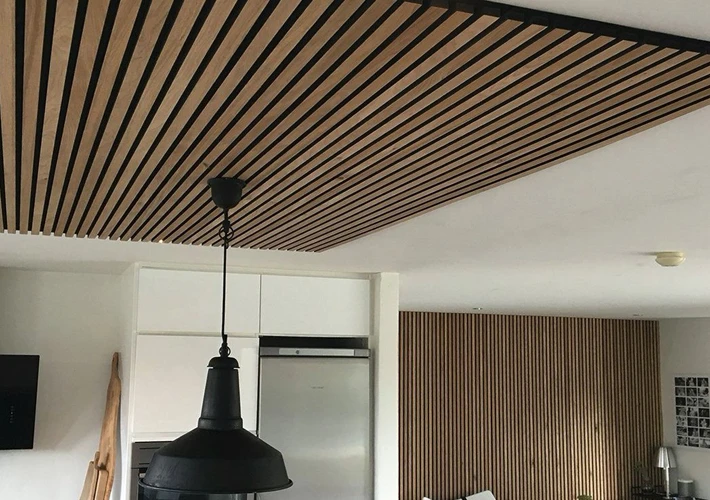
Design Flexibility and Aesthetic Value
Modern ceiling acoustic panels are no longer limited to functional designs. Architects and interior designers now treat them as decorative focal points, thanks to:
- Variety of shapes: Tiles, baffles, rafts, clouds.
- Color customization: Matching corporate branding or interior palettes.
- Integration with lighting: Acoustic panels can incorporate LED lighting systems.
- Patterns and textures: From wood slats to artistic prints, panels enhance the visual appeal of interiors.
Installation Methods
6.1 Suspended Grid Systems
- Panels are laid into a T-bar grid structure.
- Easy to install and replace.
- Common in offices and schools.
6.2 Direct Mount Systems
- Panels are directly attached to ceilings with adhesive or clips.
- Saves ceiling height, suitable for residential and small spaces.
6.3 Acoustic Baffles and Clouds
- Hung vertically or horizontally from the ceiling.
- Effective in open spaces with exposed ceilings.
- Adds visual dynamics and modern aesthetics.
Benefits of Acoustic Ceiling Panels
Improved Speech Intelligibility: Ensures effective communication.
Noise Reduction: Reduces stress, improves productivity.
Aesthetic Appeal: Enhances interior design.
Thermal Insulation: Some materials improve energy efficiency.
Fire Safety: Many panels are fire-rated.
Eco-Friendliness: Recycled materials support sustainable goals.
Market Trends and Future Outlook
8.1 Rising Demand for Healthy Indoor Environments
Post-pandemic, people value acoustic comfort as part of overall well-being, pushing demand in workplaces, schools, and healthcare.
8.2 Integration with Smart Buildings
Future ceiling acoustic panels may integrate with IoT sensors, lighting, and HVAC systems, offering multifunctionality.
8.3 Growing Popularity of Sustainable Materials
Recycled PET, bamboo charcoal veneer, and wood-based acoustic products are gaining traction, especially in Europe and North America.
8.4 Expansion in Emerging Markets
Rapid urbanization in Asia, the Middle East, and Africa creates new opportunities for acoustic ceiling panels.

Case Studies
Case 1: Office Headquarters in New York
Installation of PET acoustic ceiling clouds reduced ambient noise by 40% and increased employee satisfaction scores by 25%.
Case 2: University Auditorium in London
Wooden slat ceiling panels provided both aesthetic elegance and improved sound clarity for lectures and performances.
Case 3: Five-Star Hotel in Dubai
Fabric-wrapped acoustic ceilings in banquet halls enhanced luxury ambience and reduced noise during large events.
Conclusion
Acoustic panels for ceilings have evolved far beyond simple noise-reducing solutions. In modern architecture, they represent a fusion of functionality, sustainability, and aesthetics. From offices to schools, from hospitals to homes, acoustic ceilings are essential in creating spaces that are not only beautiful but also acoustically comfortable.
As the architectural industry continues to prioritize green building standards, human-centered design, and technological integration, ceiling acoustic panels will remain a cornerstone of interior design and construction worldwide.
For importers, wholesalers, and project contractors seeking reliable solutions, choosing high-quality acoustic ceiling panels from trusted manufacturers is critical. By combining innovative materials, design flexibility, and excellent acoustic performance, these products will continue to shape the future of modern architecture.


